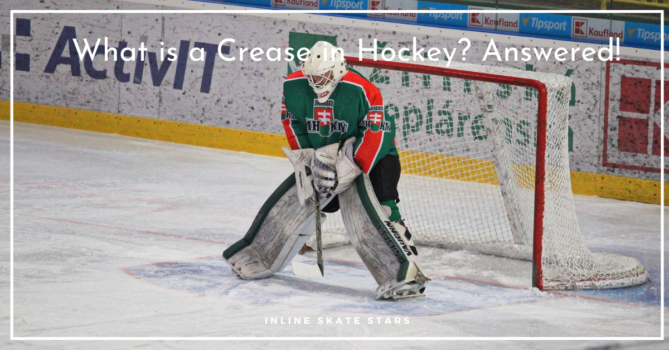What is a crease in hockey? This is one of the frequently asked questions by newbie hockey players and enthusiasts. The goalie position is one of the most exciting to play. This position depends on the crease for optimum performance—defending and blocking attempts from opponents to score a goal.
If you’re wondering what a crease is in hockey, it’s the light blue shaded zone in front of a hockey goalie’s net. The hockey crease serves many purposes. However, the main one is to help goalies defend the team by blocking puck shots from opponents.
That’s only the tip of the iceberg. There’s a lot more about hockey crease you’re yet to discover. However, that’s only possible if you stay with me to the end. So, without much ado, let’s get to it!
What is a Crease in Hockey?
The hockey crease in hockey is the light blue shaded zone in front of a hockey goalie’s net. It’s a goalie’s domain, where he/she has the maximum power and influence. Hockey goalies control what happens around and within the crease.
Its most important function is to help the goalie protect the goal by preventing puck shots. There are many rules governing ice hockey and crease is one of them.
As a new goalie, forward, or defender, you want to know what a crease is to play in cohesion with the rest of the team members.
Hockey Crease Size
How big is a hockey crease? You’re probably asking. First, the crease is drawn from a semi-circle on the goalie’s touchline. Inside the semi-circle, there’s the goalie net, measuring 6 feet wide.
One foot from the goalie net from both sides, a 4 feet crease is drawn into the hockey rink. Lastly, the two creases are connected through a 6 feet semi-circle. Overall, the National Hockey league crease is 8 feet wide.
How Important is the Hockey Crease?
Like we’ve already seen, the hockey crease plays an important role in any ice hockey game. Let’s take a deep dive into how important the crease is and how it influences how other players relate to the goalie.
1. Hockey Goalies Reference for Strategic Positioning
A goalie’s main job is to block opponents from scoring. The task is demanding and is nowhere close to what it seems like at the face value.
If you asked an experienced NHL goalie, they’ll confirm how playing goalie position is one of the hardest.
A goalie needs maximum concentration while at it. Otherwise, it’s easy to lose a match when the goalie allows the shots into the net.
The good news is, this is where the crease comes in handy. A crease is a goalie’s reference for strategic positioning.
This way, they can see all players and how they’re making moves. As a rule of thumb, you’ll often see experienced goalies coming to the top of the crease.
This is a goalie’s strategy to cut down the angle, thereby staying at the optimal position to protect the net.
2. Goalies’ Stronghold for Blocking Puck Shots
Goalies have one of the toughest jobs—blocking opponents’ efforts of scoring if they go past the defensemen. The problem is, sometimes it’s hard for goalies to save the day because they have to be all over the goalie area.
To make it worse, they need to be agile and freely move while wearing the relatively heavy hockey goalie equipment.
It can be a little frustrating for them! The good news is, this is where the crease comes in handy.
Inside this light blue shaded area, is the goalie’s stronghold for blocking puck shots hassle-free.
According to NHL crease rules, a goalie is allowed to cover the puck to stop it from moving into the net.
This is the reason why it’s easier for the goalie to freeze the puck while in the crease.
3. Goalies’ Safety Zone
The crease is a goalie’s safety zone! How is that? You’re probably asking. According to the crease rules, it’s forbidden to come into contact with the goalie while he/she is in the crease.
The goalie can, therefore, comfortably stop the puck without worrying about aggressive opponents.
Hockey Crease Rules
We’ve already touched on some of the hockey crease rules, though lightly. Next, we want to dive deeper to understand all hockey crease rules.
This knowledge goes a long way if you’re a beginner goalie or you play other positions in ice hockey.
- Attacking players shouldn’t make unnecessary contact with the goalie while in the crease.
- An attacking player is only allowed into the crease after the puck goes in.
- Attacking players are allowed into the crease. However, they shouldn’t come in the way to prevent the goalie from defending the goal.
- Goals will be disallowed on the referees’ discretion if they decide the attacking player has interfered with a goalie’s ability to defend the goal.
- Defensive players aren’t allowed to cover or grab the puck while in the crease. Referees can award penalty when this rule is disregarded.
History of the Ice Hockey Crease
Ice hockey rinks have had the modern crease for a little over 3 decades. Back in the day ice hockey rinks were pretty basic—they only had a face-off dot and lines guiding where the net should be. However, in 1929, the first crease-like feature was introduced to the sport.
The first hockey crease was a face-off dot marked in front of the goalie’s net. NHL rules around this time only permitted the goalie to stand in the crease zone—the area between the dot marking and the net.
Four years later (1933), two more dots were introduced—only that they were drawn on each side of the net. This became the new goalie’s safety zone.
Also, the crease’s new dimensions were 8 feet by 5 feet. Later in 1934, the dots were joined using red paint to create the first complete hockey crease.
Fifty-seven years later (1991), the crease was modified to what it is today—the light blue painted area in front of the goalie’s net. Overall, the hockey crease keeps getting better and better over the years.
The Referee Crease
The referee crease is a 10-foot semi-circle used by ice hockey referees when play is stopped. It is located in front of the penalty timekeeper’s seat.
This is where referees and other officials stand to deliberate courses of action.
According to ice hockey guidelines, except when invited, players aren’t allowed in the referee crease. Therefore, the referee crease is the referees’ safe zone for decision-making.
What is a Crease in Hockey? Wrapping Up
The hockey crease is the light blue painted area located directly in front of the goalie’s net. If you’ve been wondering what a crease is, I believe I answered your question as detailed as possible.




